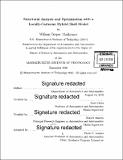Structural analysis and optimization with a locally-Cartesian Hybrid Shell Model
Author(s)
Thalheimer, William Cooper
DownloadFull printable version (14.64Mb)
Other Contributors
Massachusetts Institute of Technology. Department of Aeronautics and Astronautics.
Advisor
Mark Drela and Robert Haimes.
Terms of use
Metadata
Show full item recordAbstract
The Hybrid Shell Model (HSM) is presented as an intermediate-fidelity structural model well suited for conceptual design of aerospace vehicles. Although significantly simpler and more economical than full 3D elasticity models, it can still capture full 3D geometries, large deformations, and anisotropic materials. HSM is formulated from the full 3D equilibrium and compatibility equations all projected onto local bases defined on the 2D shell manifold. General anisotropic constitutive equations are also formulated in the local 2D shell manifold bases. The resulting continuous HSM formulation is discretized in weak form with a Galerkin finite element method (FEM), with spherical interpolation used for the local basis vectors. Displacements, basis rotations, and stress resultants are the primary unknowns. A fully adjoint-consistent plane-stress HSM version (HSM2D) is developed for the purpose of model verification and demonstration of order-of-accuracy convergence. The Method of Exact Solutions (MES) is applied to the case of a uniform plate hanging under its own weight. The effectiveness of the adjoint model for structural optimization is also demonstrated for a simplified rotor blade in a centrifugal force field, featuring non-uniform forcing, non-zero Poisson ratio, large deflection, and optimization of multiple parameters. The suitability of HSM as an intermediate fidelity conceptual aircraft design tool is thus demonstrated.
Description
Thesis: S.M., Massachusetts Institute of Technology, Department of Aeronautics and Astronautics, 2016. Cataloged from PDF version of thesis. Includes bibliographical references (pages 131-133).
Date issued
2016Department
Massachusetts Institute of Technology. Department of Aeronautics and AstronauticsPublisher
Massachusetts Institute of Technology
Keywords
Aeronautics and Astronautics.